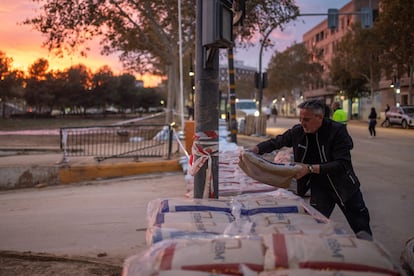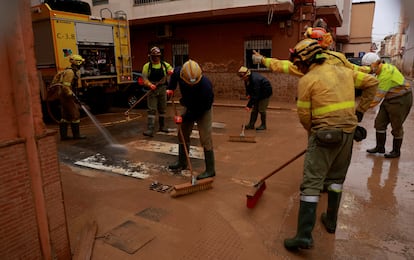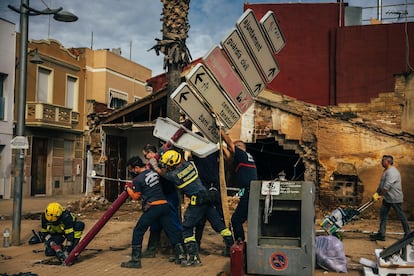Torrential rains paralyze Málaga with over 4,000 evacuated; Warning raised to red in Valencia two weeks after tragedy
Parts of Catalonia and Málaga are on red alert for intense rainfall, and scores of towns have cancelled classes. After being accused of a slow response last time around, authorities are now rushing to warn citizens to stay safe and promising cabinet reshuffles

Spain awoke on Wednesday to more torrential rain and extreme weather warnings, just two weeks after the country experienced its biggest natural disaster of the century. The record rain and flash flooding of October 29 left a trail of at least 223 deaths as well as ravaged homes, schools and infrastructure in eastern Spain, with most of the destruction concentrated in the province of Valencia. Several people are still reported missing. On Wednesday, rescuers found the bodies of two young brothers, ages three and five, who went missing two weeks ago after a rush of water entered their home in Torrent (Valencia), dragging them away.
The national meteorology agency Aemet had nine regions on alert for a fresh episode of torrential rains caused by a new DANA — when cold air pockets at high altitude encounter the heat and humidity rising from the waters of the Mediterranean, a weather event typical of the fall. The Andalusian province of Málaga and the south of Tarragona, in Catalonia, were on red alert by Wednesday morning, and Aemet warned that these areas could see rainfall of up to 180mm in a 12-hour interval. “The danger is extreme. Waterways could overflow and there could be flooding. Exercise caution!” urged Aemet on social media.
In the provincial capital of Málaga, flooding was reported in several locations, including Clínico Hospital and the University of Málaga, and the high-speed rail service between Málaga and Madrid was suspended. Over 4,000 people have been evacuated from their homes throughout the province.

Orange and yellow alerts were effective in the Valencia region — later raised to red in the latter, with the warning in place until midday Thursday — the Balearic Islands, Murcia and various parts of Andalusia and the Catalan coast. In the Valencia region, which includes the provinces of Valencia, Alicante and Castellón, heavy rainfall and some flooding was recorded in the latter province early on Wednesday, and many local authorities throughout the region urged residents to minimize road travel and to stay away from underpasses, rivers and ravines; dozens of schools shut down for the day and cultural and sports activities were canceled. In the popular coastal town of Jávea, rain gauges recorded 195mm of rainfall, leading local authorities to fear that the main road into town could be compromised.
In the regions of Catalonia, the Balearic Islands and Andalusia, local and regional governments also rolled out preventive measures. Around 3,000 people were evacuated on Tuesday in the Málaga province municipalities of Álora, Cártama, Alhaurín de la Torre, Pizarra and Málaga, which were significantly affected by the floods just two weeks ago.
A rush to warn citizens

The scale of the damage and the slow response by authorities following the events of October 29 led to a wave of public anger and street protests, and this time around officials have been quick to issue alerts. Spain’s second deputy prime minister, Yolanda Díaz, posted a message on the social network X saying that “when there are Red Alerts it is possible to NOT go to work if there is a risk to the workers. Businesses have the obligation to adopt all necessary measures to protect the workers’ lives.” And the minister for Territorial Policy, Ángel Víctor Torres, appeared before Congress on Wednesday morning to explain the government’s actions in connection with the October 29 tragedy. Defense Minister Margarita Robles is expected to address the Senate later in the day.
“Logically, after what happened, special attention is being paid now,” said Carlos Mazón, the premier of the Valencia region, in a statement on Tuesday. Mazón, of the conservative Popular Party (PP), has come under particularly intense fire over his handling of the emergency two weeks ago, and he is expected to announce a cabinet reshuffle on Thursday but to fall short of stepping down himself, as demanded by around 130,000 protesters in the city of Valencia last Saturday. Mazón has blamed agencies dependent on the national government, led by Pedro Sánchez of the Socialist Party (PSOE), for failing to warn citizens in time, even though phone alerts fall under the power of regional governments. The regional leftist political party Compromís has accused Mazón of “reckless homicide” over his role in disaster management. The premier is expected to fire Salomé Pradas, his chief of Interior and Justice and the person in charge of overseeing the emergency services, and to create a new department to lead the reconstruction effort.
On Tuesday, King Felipe VI visited Valencia province, where there are over 8,000 troops helping deal with the damage from the October 29 flooding. In the company of Defense Minister Robles, the monarch stopped at the Jaime I army base in Bétera (north of the city of Valencia); at the ship Galicia, which has been moored at the port of Valencia since November 4, and at the conference center Feria de Muestras de Valencia, in the regional capital, where the army has set up its main logistics base for this emergency. A recent visit by Felipe VI, Queen Letizia and government officials to Paiporta, a hard-hit town, ended with the authorities getting pelted with mud.

In towns already hard hit by the flooding two weeks ago, such as Paiporta, Picanya, Chiva and Aldaia, some residents piled up sandbags on Tuesday to protect themselves against potential new flooding.
The new weather event comes just as a global climate summit gets underway in Baku (Azerbaijan). On Tuesday, Spanish Prime Minister Sánchez mentioned the tragedy in Valencia, holding it up as an example of what scientists have been warning about for years: that climate change is taking lives and causing millions in economic losses. “It is not an isolated event, climate change kills, we must act,” said Sánchez.
Sign up for our weekly newsletter to get more English-language news coverage from EL PAÍS USA Edition
Tu suscripción se está usando en otro dispositivo
¿Quieres añadir otro usuario a tu suscripción?
Si continúas leyendo en este dispositivo, no se podrá leer en el otro.
FlechaTu suscripción se está usando en otro dispositivo y solo puedes acceder a EL PAÍS desde un dispositivo a la vez.
Si quieres compartir tu cuenta, cambia tu suscripción a la modalidad Premium, así podrás añadir otro usuario. Cada uno accederá con su propia cuenta de email, lo que os permitirá personalizar vuestra experiencia en EL PAÍS.
¿Tienes una suscripción de empresa? Accede aquí para contratar más cuentas.
En el caso de no saber quién está usando tu cuenta, te recomendamos cambiar tu contraseña aquí.
Si decides continuar compartiendo tu cuenta, este mensaje se mostrará en tu dispositivo y en el de la otra persona que está usando tu cuenta de forma indefinida, afectando a tu experiencia de lectura. Puedes consultar aquí los términos y condiciones de la suscripción digital.
More information
Archived In
Últimas noticias
Most viewed
- Sinaloa Cartel war is taking its toll on Los Chapitos
- Oona Chaplin: ‘I told James Cameron that I was living in a treehouse and starting a permaculture project with a friend’
- Reinhard Genzel, Nobel laureate in physics: ‘One-minute videos will never give you the truth’
- Why the price of coffee has skyrocketed: from Brazilian plantations to specialty coffee houses
- Silver prices are going crazy: This is what’s fueling the rally











































